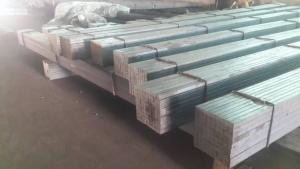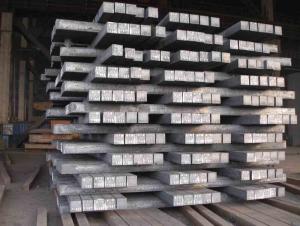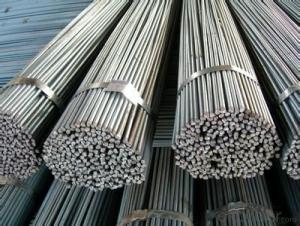Square steel bar
- Loading Port:
- China Main Port
- Payment Terms:
- TT or LC
- Min Order Qty:
- 50Tons m.t.
- Supply Capability:
- 500 tons per month m.t./month
OKorder Service Pledge
OKorder Financial Service
You Might Also Like
We offer Square Steel Bar with grade Q195 / Q235
Specifications of Square Steel Bar:
-Standard: GB,
-Grade: Q195/Q235 or equivalent.
Chemical Composition:
-Chemical Composition. Q195
|
Standard |
Grade |
Element (%) | ||||
|
GB |
Q195 |
C |
Mn |
S |
P |
Si |
|
0.06~0.12 |
0.25~0.50 |
≤0.050 |
≤0.045 |
≤0.30 | ||
-Chemical Composition. Q235
|
Standard |
Grade |
Element (%) | ||||
|
GB |
Q235B |
C |
Mn |
S |
P |
Si |
|
0.12~0.20 |
0.30~0.70 |
≤0.045 |
≤0.045 |
≤0.30 | ||
Measures and Tolerances of Square Steel Bar:
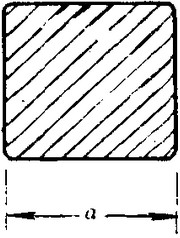
(The section of Square Steel Bar)
-The length of a side and the theoretical weight of Square Steel.
|
Length of a side(a, mm) |
Theoretical weight(kg/m) |
Length of a side(a, mm) |
Theoretical weight(kg/m) |
|
6 |
0.283 |
32 |
8.04 |
|
7 |
0.385 |
*33 |
8.55 |
|
8 |
0.502 |
34 |
9.07 |
|
9 |
0.636 |
*35 |
9.62 |
|
10 |
0.785 |
36 |
10.17 |
|
11 |
0.950 |
38 |
11.24 |
|
12 |
1.13 |
40 |
12.56 |
|
13 |
1.33 |
42 |
13.85 |
|
14 |
1.54 |
45 |
15.90 |
|
15 |
1.77 |
48 |
18.09 |
|
16 |
2.01 |
50 |
19.63 |
|
17 |
2.27 |
53 |
22.05 |
|
18 |
2.54 |
*55 |
23.6 |
|
19 |
2.82 |
56 |
24.61 |
|
20 |
3.14 |
*58 |
26.4 |
|
21 |
3.46 |
60 |
28.26 |
|
22 |
3.80 |
63 |
31.16 |
|
*23 |
4.15 |
*65 |
33.17 |
|
24 |
4.52 |
*68 |
36.3 |
|
25 |
4.91 |
79 |
38.49 |
|
26 |
5.30 |
75 |
44.16 |
|
*27 |
5.72 |
80 |
50.24 |
|
28 |
6.15 |
85 |
56.72 |
|
*29 |
6.60 |
90 |
63.59 |
|
30 |
7.06 |
95 |
70.85 |
|
*31 |
7.54 |
100 |
78.50 |
Notes:
1, The theoretical weights in the list, base on the density of 7.85 g/cm3.
2, The numbers with *mean that they are not regulars or we don’t offer them.
-The allowed tolerance of Square Steel:
|
Length of a side(mm) |
Allowed Tolerance | ||
|
Group1 |
Group2 |
Group3 | |
|
5.5~7 |
±0.20 |
±0.30 |
±0.40 |
|
7~20 |
±0.25 |
±0.35 |
±0.40 |
|
20~30 |
±0.30 |
±0.40 |
±0.50 |
|
30~50 |
±0.40 |
±0.50 |
±0.60 |
|
60~80 |
±0.60 |
±0.70 |
±0.80 |
|
80~110 |
±0.90 |
±1.0 |
±1.1 |
|
110~150 |
±1.2 |
±1.3 |
±1.1 |
|
150~190 |
―― |
―― |
±2.0 |
|
190~250 |
―― |
―― |
±2.5 |
Usage/Applications of Steel Square Bar:
-The Square Steel is normally used as structure steel.
-Row material for other structure steel like steel angles, channels, I-beams, H-beams, etc…
Packaging & Delivery of Steel Square Bar:
-Packing Detail: The products can be packed in bundles by steel wires.
-Marks:
1, Tag marks: the tag marks will be tied up to each bundle of the products. The information is usually including supplier’s logo and name, product name, made in China, products’ specifications, the painted color and other information requested by customers.
2, Color marks: we will paint both ends of the bundles of these products to make sure that they are more evident. It’s will be more convenient for the customers to distinguish them at the destination port.
-Delivery Detail: 30~45 working days after receive buyer’s T.T. or L/C.
Transportation:
-The products can be delivered by bulk vessel or by container. As for container, products with the length of 6m will be loaded in 20’ container, with 9m or 12m, in 40’ container.
-The maximum quantity of loading of container is 25 tons.
-The products usually are transported to the nearest port from the production place.
Payment:
-Invoicing on theoretical weight or actual weight a s customer’s request.
-FOB, CFR or CIF.
-Regular terms of payment:
1, 30% payment in advance, the remaining balance (70% payment) against the copy of B/L.
2, 30% payment in advance, the remaining balance (70% L/C) against the copy of B/L.
3, Negotiable.
Photos of Square Steel Bar:

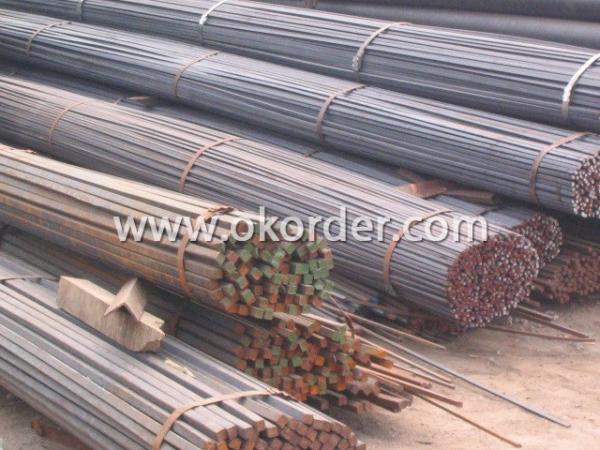
We sincerely welcome partners around the world to establish business cooperation with us on the basis of mutual trust, benefit and development.
- Q:Can a steel square be used for marking out finger joints?
- Certainly! The utilization of a steel square for marking out finger joints is indeed possible. In the realm of woodworking and carpentry, a steel square is a tool of great versatility and precision. It boasts a 90-degree angle and a ruler positioned along its edge, rendering it an ideal instrument for delineating straight lines and angles. In order to achieve a proper fit, accuracy plays a pivotal role when crafting finger joints. By employing a steel square, one can skillfully designate the necessary lines and angles required to fabricate these joints, thereby enabling meticulous and immaculate cuts. It is worth noting, however, that finger joints necessitate meticulous measurements and layout. Thus, for optimal outcomes, it is recommended to employ either a specialized finger joint jig or a dado blade on a table saw.
- Q:100*100*2.5 square with 20 square meters of housing security light steel structure:
- What is the covering frame above, how much weight is the use of PC plates or laminated glass or three layer hollow glass, covering the different weight of great disparity, has the distinction of frame grid size.
- Q:Can a steel square be used for checking the squareness of deck posts?
- Deck posts can be checked for squareness using a steel square. A steel square, also called a framing square or carpenter's square, is a versatile tool commonly used in carpentry and construction. It consists of a long arm and a shorter arm that form a right angle. One of its main purposes is to ensure that corners and angles are perfectly square. To check the squareness of deck posts with a steel square, follow these steps: 1. Place the steel square against one side of the deck post, making sure that the long arm rests against the post while the shorter arm extends vertically. 2. Check the alignment of the shorter arm with the adjacent side of the deck post. If the post is square, the shorter arm of the steel square should be flush against the post without any gaps or overlaps. 3. Repeat this process on all four sides of the deck post to confirm its squareness. If the steel square consistently aligns flush with all sides, the post can be considered square. 4. If the steel square does not align properly or there are gaps or overlaps, make adjustments to the post. This may involve repositioning or remeasuring the post to ensure it is at a right angle to the deck surface. It is important to note that while a steel square is an effective tool for checking the squareness of deck posts, it should be used in conjunction with other methods, such as measuring diagonals or using a level, to ensure accurate and precise results.
- Q:Can a steel square be used for checking the plumbness of a beam?
- Incorrect, a steel square is not suitable for assessing the verticality of a beam. A steel square, also referred to as a framing square, primarily serves the purpose of measuring and marking right angles. It lacks the necessary design and calibration for determining the plumbness of a beam. In order to properly assess the verticality of a beam, it is recommended to utilize either a level or a plumb bob. A level is equipped with a bubble vial that indicates whether a surface is oriented vertically or horizontally, while a plumb bob consists of a weighted string that hangs in a straight line to establish a true vertical reference. These tools are specifically engineered for evaluating plumbness and offer superior accuracy in comparison to a steel square.
- Q:How do you use a steel square to lay out a common rafter?
- To lay out a common rafter, you can follow these steps by employing a steel square: 1. Begin by determining the roof pitch, which indicates the angle of the roof's slope. It is typically expressed as a ratio like 4:12 or 6:12, with the first number representing the rise and the second number representing the run. 2. Measure the span of the roof, which is the horizontal distance from one outer wall to the other. This measurement determines the length of the rafter. 3. Place the steel square on a flat surface with the blade facing towards you and the tongue pointing away. 4. Locate the pivot point on the square, where the blade and tongue meet. This point is usually marked with a small hole or notch. 5. Align the square's pivot point with the end of the square against the edge of the lumber from which you will be cutting the rafter. Ensure that the square is parallel to the lumber's edge. 6. Using the rise and run measurements, find the corresponding numbers on the steel square. These markings are typically present along the blade and tongue. 7. Once you identify the rise and run measurements, mark the points on the lumber where the blade and tongue intersect using a pencil or marker. 8. Connect the marked points with a straight line to create the rafter's outline. 9. Repeat this procedure for each rafter, taking into account any variations in the roof's pitch or span. By utilizing a steel square to lay out a common rafter, you can achieve precise and accurate cuts, ensuring that the rafter fits correctly and provides the necessary support for the roof structure.
- Q:How accurate are steel squares for measuring?
- Steel squares are known for their high accuracy in measuring angles and lengths. They are precision tools that are typically made from hardened steel, providing stability and durability. When properly calibrated and used correctly, steel squares can provide accurate measurements for a wide range of applications. One of the key advantages of steel squares is their ability to maintain their accuracy over time. Unlike other materials, steel does not warp or deform easily, ensuring that the measurements obtained are reliable and consistent. This stability makes steel squares a preferred choice in various industries, including woodworking, metalworking, and construction. Furthermore, the edges and surfaces of steel squares are precisely machined, allowing for accurate alignment and marking. The right angles formed by the square are typically very close to perfect 90-degree angles, making them suitable for tasks that require precise right angles, such as squaring up corners or checking the accuracy of machinery. However, it is worth noting that the accuracy of steel squares can be influenced by factors such as user error, wear and tear, or improper storage. To ensure the highest level of accuracy, it is important to handle steel squares with care and to periodically check their calibration using a reliable reference square or angle gauge. In conclusion, steel squares are generally highly accurate tools for measuring angles and lengths. With their robust construction and precise machining, they provide consistent and reliable results. By properly maintaining and calibrating them, steel squares can be trusted for a wide range of measurement tasks.
- Q:Can a steel square be used for checking the squareness of a lathe tool rest?
- No, a steel square cannot be used for checking the squareness of a lathe tool rest. Steel squares are typically used for checking the squareness of flat surfaces or right angles, such as in woodworking or construction. The tool rest on a lathe is a curved or angled surface, and therefore requires a different tool for checking its squareness. A more suitable tool for checking the squareness of a lathe tool rest would be a precision square or a bevel gauge, which are specifically designed for measuring angles and can accommodate curved or angled surfaces.
- Q:How accurate are steel squares?
- Steel squares are generally considered to be highly accurate measuring tools. Their accuracy depends on the quality of the manufacturing and the precision of the markings on the square itself. High-quality steel squares have precise angles and straight edges, allowing for accurate measurements and squareness checks. However, it is important to note that even the best steel squares may have slight variations due to manufacturing tolerances. To ensure the accuracy of a steel square, it is recommended to check it against a known reference or a precision measuring instrument. This can be done by placing the square against a flat surface and verifying that the edges are parallel and the angles are square. If any discrepancies are found, adjustments can be made or the square can be replaced if necessary. Overall, steel squares are generally reliable and accurate tools for measuring and checking squareness. However, it is always important to verify their accuracy and perform regular maintenance to ensure their continued precision.
- Q:What is the cold drawn steel material? Why did it break?
- 20 steel 45 steel Q235B a little more material, no annealing treatment
- Q:What are some common uses of a steel square in metalworking tool fabrication?
- A steel square, also known as a framing square or a carpenter's square, is a versatile tool commonly used in metalworking tool fabrication. Some of the common uses of a steel square in metalworking tool fabrication include: 1. Layout tool: Steel squares are used to mark and layout lines on metal sheets or workpieces. They provide accurate and straight angles for precise measurements and markings. 2. Right angle reference: Steel squares are ideal for checking and ensuring right angles in metalworking projects. By aligning the square's edges with the workpiece, one can easily verify if the corners are perfectly square. 3. Cutting guide: Steel squares can act as a cutting guide when performing tasks like sawing, shearing, or scoring metal sheets. The square's straight edge can be used as a reference to guide the cutting tool and ensure straight and accurate cuts. 4. Measuring tool: Steel squares come with graduated scales along the edges, allowing for quick and accurate measurements of lengths and angles. These measurements are crucial for ensuring precise dimensions and fit in metalworking tool fabrication. 5. Welding aid: Steel squares can be used as a guide during welding processes. They help in positioning and aligning metal pieces to be welded, ensuring that they are perfectly aligned and at the desired angle. 6. Checking for flatness: Steel squares can be used to check the flatness of a metal surface. By placing the square on the surface and observing the gaps, one can identify any irregularities or unevenness that need to be addressed. Overall, the steel square is a versatile and essential tool in metalworking tool fabrication. Its ability to provide accurate measurements, verify right angles, and act as a cutting and welding guide makes it invaluable for ensuring precision and quality in metalworking projects.
1. Manufacturer Overview |
|
|---|---|
| Location | Renqiu, China |
| Year Established | 1996 |
| Annual Output Value | Above US$ 30 Million |
| Main Markets | Mid East; Southeast Aisa |
| Company Certifications | |
2. Manufacturer Certificates |
|
|---|---|
| a) Certification Name | |
| Range | |
| Reference | |
| Validity Period | |
3. Manufacturer Capability |
|
|---|---|
| a)Trade Capacity | |
| Nearest Port | Tianjin; |
| Export Percentage | 20% - 30% |
| No.of Employees in Trade Department | 11-20 People |
| Language Spoken: | English; Chinese |
| b)Factory Information | |
| Factory Size: | Above 70,000 square meters |
| No. of Production Lines | 1 |
| Contract Manufacturing | OEM Service Offered |
| Product Price Range | Average |
Send your message to us
Square steel bar
- Loading Port:
- China Main Port
- Payment Terms:
- TT or LC
- Min Order Qty:
- 50Tons m.t.
- Supply Capability:
- 500 tons per month m.t./month
OKorder Service Pledge
OKorder Financial Service
Similar products
New products
Hot products
Related keywords




















